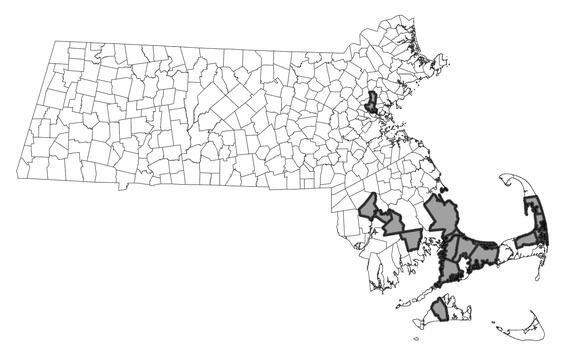- Scientific name: Coreopsis rosea Nutt.
- Species of Greatest Conservation Need (MA State Wildlife Action Plan)
Description
Rose coreopsis is a showy perennial composite with pink, daisy-like flowers that have a yellow center. Plants grow up to about 60 cm (2 ft) high, in clumps or small groups. The stems are often unbranched and the opposite leaves are very narrow and thread-like. There are no basal leaves. The flowers are a 1.27-2.54 cm (0.5 in-1 in) across and appear in summer and fall.
Life cycle and behavior
Flowers bloom in summer and fall.
Population status
Rose coreopsis is a species of greatest conservation need and is maintained on the plant watch list. It is globally rare but Massachusetts has many populations. Most of the current populations of rose coreopsis are in eastern Massachusetts, in Barnstable, Bristol, Dukes, Middlesex, and Plymouth counties. The species was also found historically in Norfolk County. Although it is a globally rare species, this plant grows on the shores of most coastal plain ponds in Massachusetts, often with numbers over 100 stems; at some, the stems count is tens of thousands.
Distribution and abundance
Rose coreopsis is a globally rare species with a limited and disjunct range. It is considered of conservation concern in every state and province where it occurs. It is presumed extirpated from Pennsylvania, critically imperiled in Delaware, Georgia, and Maryland, imperiled in New Jersey, Nova Scotia, Rhode Island and South Carolina and vulnerable in Massachusetts and New York.

Distribution in Massachusetts
1999-2024
Based on records in the Natural Heritage Database
Habitat
Rose coreopsis grows on the edges of coastal plain ponds, a globally rare type of freshwater pond. Coastal plain ponds are usually fed by groundwater, with no inlets or outlets, and hence have water levels that vary widely over the year. Rose coreopsis usually grows on the gently sloping sandy shores of these ponds close to the water’s edge, where it can be inundated by water level changes. Associated species include Plymouth gentian (Sabatia kennedyana), redroot (Lachnanthes caroliana), terete arrowhead (Sagittaria teres), golden pert (Gratiola aurea), and northern meadow-beauty (Rhexia virginica), among other plants common to coastal plain pondshores.
Healthy habitats are vital for supporting native wildlife and plants. Explore habitats and learn about conservation and restoration in Massachusetts.
Threats
The primary threats to rose coreopsis are direct destruction of habitat by all forms of development, destruction of individual plants by off-road vehicles or trampling, displacement by invasive plant species, anthropogenic nutrient input to the naturally low-nutrient ponds, alteration of coastal plain pond hydrology by water withdrawals or climate change, and, possibly, fire exclusion. Rose coreopsis prefers open areas; where shrubs and trees invade the pondshores because they are not suppressed by fire or flooding, rose coreopsis will tend to disappear. However, this species appears better able to persist at degraded sites than other plants specialized to coastal plain pondshores.
Conservation
Habitat should be managed to have openings, perhaps through reintroduction of prescribed burns.
References
Gleason, H.A., and A. Cronquist. 1991. Manual of Vascular Plants of Northeastern United States and Adjacent Canada. Second Edition. The New York Botanical Garden, Bronx, New York.
NatureServe. 2025. NatureServe Network Biodiversity Location Data accessed through NatureServe Explorer [web application]. NatureServe, Arlington, Virginia. Available https://explorer.natureserve.org/. Accessed: 5/23/2025.
Contact
| Date published: | April 14, 2025 |
|---|